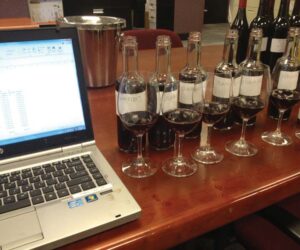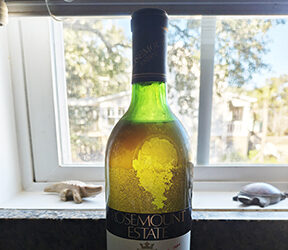
Q
I own a small store in Yellowknife, Northwest Territories. I have two customers with the same problem and I have no solution. Both batches were made with a four-week wine kit.
The first customer lives in a small northern community and has sent me a bottle of his wine, a Merlot. It is quite cloudy as though it didn’t settle. This man has bottled all of his wine and all the bottles are the same. His wine has a slight vinegar taste. I am willing to reclean this bottle if you think it would help.
The second customer lives in town. He claims his wine is crystal clear, but has not yet brought me a bottle. He also says it has a slight vinegar taste. He does not usually bottle his wine, rather leaves it in the carboy and racks it into carafes as needed. He claims the lid is on tight and the airlock is in place.
The only information I can find on this “vinegar” problem claims it’s a result of improperly cleaned equipment. Both men have been making wine for a long time, and both claim to be extremely careful in this area. They don’t believe this could be the problem. Is there a solution? And what is causing this?
Shirley Stapleton
Yellowknife, Northwest Territories
A
Seems like an attack of your friend and mine, the acetic acid bacteria. These bacteria live in wineries, on winery equipment and in the air. In fact, you’re probably breathing some in right now. Unfortunately, when these little guys come in contact with wine and oxygen, they tend to produce acetic acid, the stuff that makes vinegar smell and taste, so, well, vinegary.
Even though your customers sound like fine winemaking folk, even the best of us come up against acetobacter once in a while. As you pointed out, unclean equipment can be a contributing factor to this vinegar smell. This seems to be only part of the issue, though. Like I said above, acetic acid bacteria are everywhere. It’s very difficult for winemakers to totally eradicate them from the winemaking environment. All we can do is find ways to live with them.
Acetic acid bacteria need the following things to survive: oxygen, a hospitable environment and a food source. By controlling these factors we can reduce the chances that acetic acid bacteria will find, infect, survive in, breed in and make acetic acid in our wines. We can do this by the following:
- Keep equipment scrupulously clean at all times.
- Keep containers as full as possible, as acetic acid bacteria thrive in half-empty containers that are, by definition, half full of air.
- If there must be headspace in a barrel or carboy, blanket the surface of the liquid with carbon dioxide or nitrogen gas, if available.
- Keep pHs low (under 3.7) so that microbes will not be able to survive as well in your wines.
- Use sulfur dioxide as an antimicrobial agent, keeping free SO2s between 20 to 35 ppm (mg/L).
- Store your wines in a cool, dry area. The lower temperatures and dry air will discourage not only acetic acid bacteria but molds and fungi as well.
- Watch wines that have low alcohol levels (below 10 percent). Alcohol acts as an antimicrobial agent to some extent, and wines with low alcohol levels are especially susceptible to attack by bacteria.
- Finished wine, or wine that has just finished fermentation, is the most vulnerable to acetobacter attack since the protective layer of carbon dioxide produced during fermentation is no longer present. Keep these vulnerable wines especially clean and topped up.
- Acetobacter are often transmitted to wines by insects like fruit flies. Do your best to clean up all spilled juice, must, skins and wine before you give fruit flies – and acetic acid bacteria – a chance to thrive in your winery. Immediately clean up spills wherever they occur, and especially keep tops of barrels, carboys and fermenters clean and free of residue.
- Those tips should help both of your customers. Your first customer, who keeps his wine in filled bottles but is having problems with haze, needs to check his pHs and make sure they’re not over 3.6 to 3.7.
High pH wines lend themselves readily to both bacterial attack and haze formation. In fact, haze and instabilities are often the result of bacterial attack. Your second customer should store his wine in a more air-tight way. Even though airlocks and lids serve their purposes, air laden with oxygen and bacteria enters the carboy every time the fermentation lock is taken off to siphon out a carafe. I strongly suggest he bottle his wine or that he rack into smaller, one-gallon (3.8 L) jugs as the level in his carboy gets lower.
Q
I started making wine two years ago and it’s a lot of fun. I do some kits, but mostly, I find fruit more interesting.
I test my wine musts for TA, but have learned from reading WineMaker that pH is also important. I know how to adjust my TA, but how do I adjust pH without changing the TA? What ingredient is used to do this?
John Dzioba
Winnipeg, Manitoba
A
Ask almost any commercial winemaker and they will say that pH is one of the most important-if not the most important-winemaking parameter. Even though TA is important for the way a wine will taste, and is certainly an important number, adequate pH numbers are even more critical to the microbial and chemical stability of wines.
To take pH into consideration, one must have a reliable way of measuring it. Unfortunately, pH meters are relatively expensive (your wine shop can quote you a price), but are a good investment for the serious winemaker. Litmus strips are cheaper, but don’t even do a halfway decent job – they shouldn’t be used. PHs for healthy wines should be between 3.1 to 3.7. Any lower and your yeast or malolactic bacteria will not survive. Any higher and spoilage microbes will find your wine a welcome home.
Any way you slice it, it’s important to have a handle on your wine’s pH. Incidentally, the pH really cannot be manually adjusted without having an effect on the TA. Since they both rely on the hydrogen ion concentration in the wine (the stuff that makes acids acidic), they are completely interconnected.
PH is the measure of dissociated hydrogen ions present at any given moment, while TA is the measure of total hydrogen ions that are and will ever be present in a wine. Their relationship is not cut-and-dried, because any given adjustment in the pH will not necessarily be correlated exactly to any given change in the TA. And vice versa.
This may be getting off the topic a little bit, however, because it is a good thing that pH and TA both can be adjusted (at the same time). To raise the TA and lower the pH, most winemakers add acid in the form of purchased tartaric acid. Tartaric acid is one of the naturally present grape acids, and is not consumed by yeast or by any other microorganism in the winemaking process. What you add is what stays in the wine, unless it precipitates later with age or with cold stabilization.
Wines can be de-acidified by adding calcium or potassium carbonate. This is a laborious process and one that takes a certain amount of skill to accomplish. It is better to deal with ripe fruit in the beginning than to have to de-acidify later.
Another and much easier way to de-acidify is to use a malolactic fermentation. If your fruit source is high in malic acid (grapes and apples are, especially), then you can introduce commercial strains of lactic acid bacteria that will consume the malic acid and turn it one-for-one into lactic acid, which is a “less acidic” acid than malic acid. This will lower the pH of your wine by one or two tenths of a point, often making the difference between a stable wine and an unstable one.
Tartaric acid, pH meters, lactic acid bacteria and potassium bicarbonate are available through winemaking catalogs and supply stores.
Q
“Tips from the Pros” (Summer 1999) explains how to use ripe bananas to give body to a thin wine. Please tell me more. Why does this work? What are we pulling out of the banana by cooking that thickens the wine? What is the chemical composition or name of this derivative? What impact will it have on flavor? Will it work equally well with reds and whites, dry and sweet finishes? Could I do the same with several packages of liquid pectin, the type we use to thicken jam?
We have a very active wine club and we usually process 10 to 12 tons (9 to 10.8 metric tons) of grapes each season. We are always looking for tips. Any insight you can provide on bananas will be appreciated.
Serne Bartoletti
El Paso, Texas
A
Home winemakers use bananas, both dried and fresh, as a source of perceptible sweetness and body. Both effects are derived from the complex polysaccharides (that’s a fancy name for big, long-chain sugars) that bananas contain. By cooking the bananas or by using dried bananas (as many recipes specify), you’re taking advantage of these sugars to the maximum extent possible. Of course, adding bananas to your wines may impart some banana-like aromas and flavors – you just need to decide if this is correct for your type of wine. I would say it would be for, say, a late-harvest Muscat, but not for a bone-dry Bordeaux-style red wine.
I would use the banana trick for sweeter styles, as the amount of sugar added will be difficult to control. It would work well for sweet whites as well as sweet reds, especially Ports, when you’re concerned with getting sweetness as well as body into the finished product.
Using liquid pectin is a definite winemaking no-no. More often than not, it will contribute to unsightly hazes in finished wines.
Q
Our Zinfandel wine is now in secondary fermenters, with free-run wine separate from the pressed. Do you have advice on allowing the free and pressed wines to go their own ways – or do tannins enrich Zinfandel?
Also, I have another question: How do I locate a resource to help me understand the characteristics of various grapes that require certain techniques to bring out the best of the grape? Thanks in advance for your help.
Joseph Fiore Terrizzi
Evanston, Illinois
A
You are right on track by separating your press fractions. This is a very typical commercial winemaking maneuver that lets you have better blending control down the line – you have different wines to work with and you can use them to your advantage.
However, if you’re making wine on a very small home-winemaking scale, having five gallons (18.9 liters) of press wine and five gallons (18.9 liters) of free run might not do you too much good-you probably will find that your best wine is made by mixing the two together. Zinfandel is usually a very robust, rustic, round and rambunctious (gotta love those “R” words) wine and, as such, does benefit from a good, strong mouthfeel.
A great book that I have enjoyed immensely over the years is called Winemaking: Recipes, Equipment and Techniques for Making Wine at Home by Stanley F. Anderson and Dorothy Anderson. The Andersons cover a myriad of topics and have many wonderful recipes and procedures that will give the seasoned professional and the beginner alike an idea of how to use each grape varietal (or non-grape fruit) to its best potential.
Do you have a burning question for the mighty Wine Wizard? If so, e-mail: [email protected].







